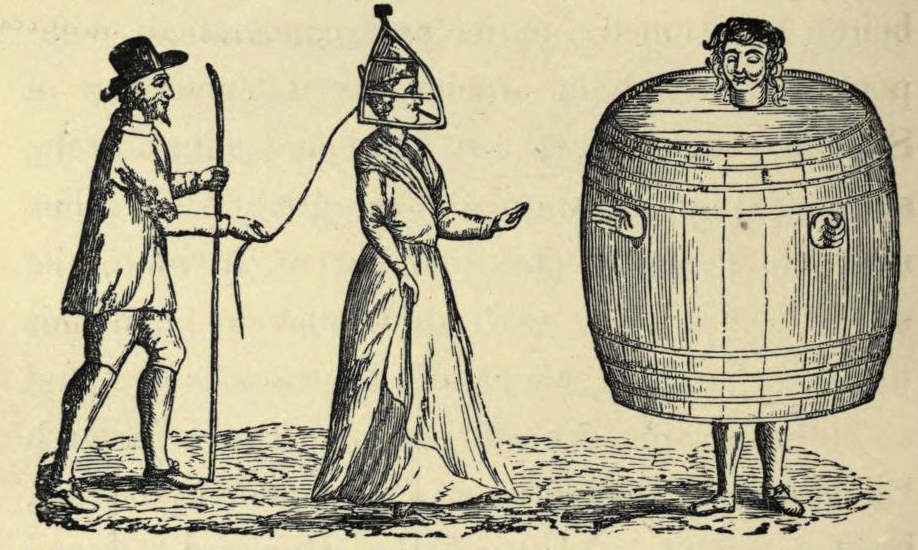Drunkard's cloak on:
[Wikipedia]
[Google]
[Amazon]

 A drunkard's cloak was a type of
A drunkard's cloak was a type of

 A drunkard's cloak was a type of
A drunkard's cloak was a type of pillory
The pillory is a device made of a wooden or metal framework erected on a post, with holes for securing the head and hands, formerly used for punishment by public humiliation and often further physical abuse. The pillory is related to the stocks ...
used in various jurisdictions to punish miscreants.
Description
The drunkard's cloak was actually a barrel, into the top of which a hole was made for the head to pass through. Two smaller holes in the sides were cut for the arms. Once suitably attired, the miscreant was paraded through the town, effectively pilloried.Offences
Drunkenness was first made a civil offence in England by the Ale Houses Act 1551, or "An Act for Keepers of Ale-houses to be bound by Recognisances". According to Ian Hornsey, the drunkard's cloak, sometimes called the "Newcastle cloak", became a common method of punishing recidivists, especially during theCommonwealth of England
The Commonwealth was the political structure during the period from 1649 to 1660 when England and Wales, later along with Ireland and Scotland, were governed as a republic after the end of the Second English Civil War and the trial and execut ...
. From 1655 Oliver Cromwell
Oliver Cromwell (25 April 15993 September 1658) was an English politician and military officer who is widely regarded as one of the most important statesmen in English history. He came to prominence during the 1639 to 1651 Wars of the Three ...
suppressed many of England's alehouses, particularly in Royalist
A royalist supports a particular monarch as head of state for a particular kingdom, or of a particular dynastic claim. In the abstract, this position is royalism. It is distinct from monarchism, which advocates a monarchical system of governm ...
areas, and the authorities made regular use of the cloak.
Accounts
An early description of the drunkard's cloak appears in Ralph Gardiner's ''England's Grievance Discovered'', first published in 1655. A John Willis claimed to have travelled toNewcastle Newcastle usually refers to:
*Newcastle upon Tyne, a city and metropolitan borough in Tyne and Wear, England
*Newcastle-under-Lyme, a town in Staffordshire, England
*Newcastle, New South Wales, a metropolitan area in Australia, named after Newcastle ...
and seen
Gardiner's account was reproduced in 1789 in John Brand's ''History of Newcastle-on-Tyne'', accompanied by an early illustration of a drunkard's cloak. A similar device was used in Holland
Holland is a geographical regionG. Geerts & H. Heestermans, 1981, ''Groot Woordenboek der Nederlandse Taal. Deel I'', Van Dale Lexicografie, Utrecht, p 1105 and former province on the western coast of the Netherlands. From the 10th to the 16th ...
; William Brereton noted its use in Delft
Delft () is a city and municipality in the province of South Holland, Netherlands. It is located between Rotterdam, to the southeast, and The Hague, to the northwest. Together with them, it is part of both the Rotterdam–The Hague metropolitan ...
in 1634, as did Samuel Pepys
Samuel Pepys (; 23 February 1633 – 26 May 1703) was an English diarist and naval administrator. He served as administrator of the Royal Navy and Member of Parliament and is most famous for the diary he kept for a decade. Pepys had no mari ...
at The Hague
The Hague ( ; nl, Den Haag or ) is a city and municipality of the Netherlands, situated on the west coast facing the North Sea. The Hague is the country's administrative centre and its seat of government, and while the official capital ...
in 1660. One author also recorded its existence in 1784 in Denmark
)
, song = ( en, "King Christian stood by the lofty mast")
, song_type = National and royal anthem
, image_map = EU-Denmark.svg
, map_caption =
, subdivision_type = Sovereign state
, subdivision_name = Danish Realm, Kingdom of Denmark
...
, where it was called the "Spanish Mantle". These occurrences, along with the observations of one 19th-century historian, who noted that no mention of the punishment was made in any local documentation, including the Newcastle Corporation accounts, prompted William Andrews to suppose in 1899 that the Drunkard's Cloak was a custom imported from the Continent, and that its use in England was confined to Newcastle.
Further afield, instances of its use are found in the US; a paper described in 1862 how a "wretched delinquent was gratuitously framed in oak, his head being thrust through a hole cut in one end of a barrel, the other end of which had been removed, and the poor fellow loafed about in the most disconsolate manner, looking for all the world like a half-hatched chicken."
See also
* Bankruptcy barrel * SchandmantelNotes
Footnotes
Citations
Bibliography
* * * * * {{refend American Civil War History of Newcastle upon Tyne Medieval instruments of torture Physical restraint Punishment